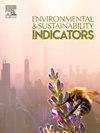Soil quality dynamics in response to land-use management types and slope positions in northeastern highlands of Ethiopia
IF 5.4
Q1 ENVIRONMENTAL SCIENCES
引用次数: 0
Abstract
To address watershed degradation in Ethiopia's northeastern highlands, diverse land-use management (LUM) practices have been implemented. However, their impacts on soil quality (SQ) vary, particularly across topographic slopes, which significantly influence erosion rates, water retention, and nutrient dynamics. Understanding these variations is crucial for designing targeted soil management strategies. This study evaluated SQ under five LUM types—enhanced forest (EF), agroforestry (AF), controlled grazing (CG), croplands with improved bunds (BCL), and traditional management (TCL)—across three slope positions in the Upper Gelana watershed. Seventy-one composite soil samples (0–30 cm) were analyzed for key SQ indicators, and Principal Component Analysis identified SOC, TN, CEC, bulk density, clay fraction, and available phosphorus as a minimum dataset for computing a soil quality index (SQI). Results revealed significant (p < 0.05) impacts of LUM types and slope positions on SQ parameters. SQI rankings were EF > AF > CG > BCL > TCL. EF soils in lower slopes achieved the highest SQI (0.981) due to superior SOC, TN, and CEC, offering benchmarks for sustainable management. AF maintained high SQI (>0.8) consistently across all slopes, demonstrating its potential for restoring degraded landscapes. TCL in upper slopes had the lowest SQI (0.6), indicating severe degradation and an urgent need to implement slope-specific management strategies, such as contour bunds with vegetation reinforcements to mitigate erosion. These findings underscore the need for integrated soil management strategies tailored to each land-use and slope needs. SQI can be used as a valuable diagnostic tool for guiding adaptive management.
埃塞俄比亚东北部高地土壤质量动态对土地利用管理类型和坡位的响应
为了解决埃塞俄比亚东北部高地流域退化问题,已经实施了多种土地利用管理(LUM)做法。然而,它们对土壤质量(SQ)的影响各不相同,特别是在不同的地形斜坡上,这显著影响侵蚀速率、保水和养分动态。了解这些变化对于设计有针对性的土壤管理策略至关重要。本研究评估了上Gelana流域3个坡位的5种LUM类型(增强林(EF)、农林业(AF)、控制放牧(CG)、改良带农田(BCL)和传统管理(TCL))下的SQ。对71个复合土壤样品(0-30 cm)进行了关键SQ指标分析,主成分分析确定了SOC、TN、CEC、容重、粘土分数和有效磷作为计算土壤质量指数(SQI)的最小数据集。结果显示显著(p <;(0.05) LUM类型和坡度位置对SQ参数的影响。SQI排名依次为EF >;房颤的在CG祝辞BCL祝辞TCL。低坡EF土壤的土壤有机碳、全氮和土壤碳含量最高,SQI为0.981,为可持续管理提供了基准。AF在所有斜坡上始终保持较高的SQI (>0.8),显示了其恢复退化景观的潜力。上坡TCL的SQI最低(0.6),表明严重退化,迫切需要实施针对坡面的管理策略,如在等高线带上增加植被以减轻侵蚀。这些发现强调需要针对每种土地利用和坡度需求制定综合土壤管理战略。SQI可以作为指导适应性管理的有价值的诊断工具。
本文章由计算机程序翻译,如有差异,请以英文原文为准。
求助全文
约1分钟内获得全文
求助全文
来源期刊

Environmental and Sustainability Indicators
Environmental Science-Environmental Science (miscellaneous)
CiteScore
7.80
自引率
2.30%
发文量
49
审稿时长
57 days
 求助内容:
求助内容: 应助结果提醒方式:
应助结果提醒方式:


